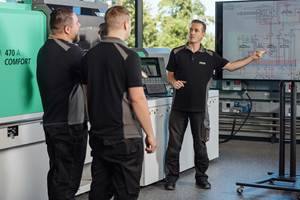Robots Manage Logistics For Entire Packaging Plant
Inventory management may be too important to be left to people.
Inventory management may be too important to be left to people. Faerch Plast A/S, a mid-sized Danish thermoformer of food trays, decided five years ago to take all human error out of storing and handling its wide array of thermoformed food trays. Faerch, which turns 40 next year, extrudes an extensive sheet inventory that includes nine colors of APET sheet, 11 colors of PS, five colors of PP, and clear PLA for approximately 900 different tray products. Certain shapes and colors are dedicated to certain customers and product lines. It’s a lot to keep track of.
“Roll storage was a logical place to begin the transition to robots,” recalls Henning Sandal, technical director, who was in charge of developing automated inventory management five years ago. The move was designed to keep pace with expansion of the company’s extrusion and thermoforming plants in Holstebro, Denmark. Faerch Plast has yearly revenues above 200 million Euros and is growing rapidly. This year it opened its first satellite plant, in the Czech Republic. Yet it employs fewer than 500 people, largely due to its reliance on robots.
AUTOMATED ROLL STORAGE
The roll-storage area looks like a scaled-up version of the stacks in a public library—only it’s four stories (over 80 ft) high. Each of the four storage walls is two rolls of film deep by 35 rolls wide by 11 rolls high. The area holds over 3000 rolls. People don’t enter here at all.
Two ladder-like picker robots slide up, down, and sideways over the storage walls of rolls. They put recently produced rolls away for later use, and remove rolls for forming on a first-in/first-out basis. The picker robots are built by Swisslog AG in Switzerland (U.S. office in Newport News, Va.).
Each roll is identified by a barcode giving production date and time, gauge, resin, and color. When a roll comes out of storage, it is delivered by a human driving a forklift truck to the thermoforming machine. But the human is double-checked by the computer controls on the thermoformer, which won’t allow it to form the wrong sheet for that job.
ROBOTIC FORKLIFTS
Faerch’s next step was to deploy specialized delivery robots around the plant. There are six battery-powered AGV (automated guided vehicle) robots from E&K Automation GmbH in Rosengarten, Germany. AGVs move noiselessly around the plant, picking up boxes of finished trays from forming machines and taking them to a computerized central storage area. The AGVs navigate around the plant with a laser guidance system. A rotating laser on the AGV “sees” fixed reflectors on the route and triangulates from these to establish its position. This makes route design far more flexible than if the robots followed a fixed track in the floor.
ROBOTS CONTROL REGRIND
The latest step in Faerch’s automation applied the AGVs to handling regrind collection. A mechanical robot on each thermoforming machine puts rolls of web skeletons into a bin. The bins are taken by AGVs, still following the material barcodes, and put into a feeder going through the floor to a grinder on a lower level, dedicated to that particular resin, and granulate is blown into a dedicated silo. “If the barcode is wrong, the grinder won’t take it,” Sandal explains.
“One robot replaces at least two people in 24 hr,” Sandal notes, though no jobs were lost to robots. “We are growing rapidly, so we just don’t hire people for those jobs.”
Related Content
PolyJohn Turns to Blow Molding, Doubles Its Productivity
Leading maker of portable sanitation products knew thermoforming, sheet extrusion, rotomolding and injection molding. Then it found the missing link to higher productivity and new markets: blow molding.
Read MoreBoston Dynamics Stretches Into Autonomous Warehouse Robotics
The robotics company’s second commercial product is designed to take on physically challenging warehouse tasks.
Read MoreFive Ways to Increase Productivity for Injection Molders
Faster setups, automation tools and proper training and support can go a long way.
Read MorePaperless ‘Smart Factory’ Based on Automated Production Monitoring
Tier 1 automotive molder’s home-built production-monitoring and ERP systems, designed for “the little guy,” boost its efficiency rating and profits.
Read MoreRead Next
People 4.0 – How to Get Buy-In from Your Staff for Industry 4.0 Systems
Implementing a production monitoring system as the foundation of a ‘smart factory’ is about integrating people with new technology as much as it is about integrating machines and computers. Here are tips from a company that has gone through the process.
Read MoreBeyond Prototypes: 8 Ways the Plastics Industry Is Using 3D Printing
Plastics processors are finding applications for 3D printing around the plant and across the supply chain. Here are 8 examples to look for at NPE2024.
Read MoreMaking the Circular Economy a Reality
Driven by brand owner demands and new worldwide legislation, the entire supply chain is working toward the shift to circularity, with some evidence the circular economy has already begun.
Read More











